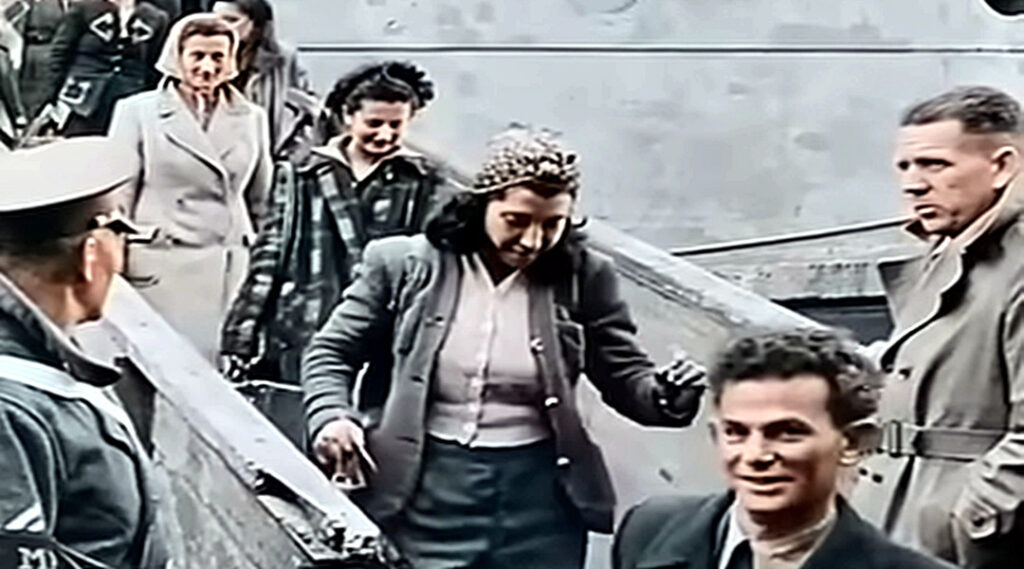By the end of World War II, a quarter of a million members of Europe’s Jewish population were left homeless, unable to return to the towns and cities they had been forced to leave. Their homes, livelihoods, and communities had been destroyed, and many who tried to go home faced ongoing antisemitic attacks or found it psychologically impossible to rebuild in the places where they had endured years of persecution at the hands of the Nazis.
Concentration camp survivors and those who had managed to evade capture throughout the war found themselves in Displaced Persons Camps across Germany, Italy, and Austria. With the UK, US, and Western European countries offering only a limited number of refugees, the majority of the 250,000 survivors declared that the only place they could rebuild their lives was their ancestral homeland of Judea, then British-administered Palestine, which was under a League of Nations mandate.
Photos and videos showing Jewish refugees disembarking vessels in British-administered Palestine after World War II are often shared on social media, with claims that Palestinians would selflessly take them in, welcoming them with open arms, and that the refugees would repay their gracious hosts by attacking them and stealing their homes and land.
The most commonly shared video pushing this false narrative is a colorized version of footage shot in late 1945, not 1947 as the text overlay suggests, which shows Jewish families disembarking a boat at the Port of Haifa. This video is usually accompanied by erroneous claims that these Holocaust survivors destabilized the entire region and brought an end to the long-standing peace between the Middle Eastern Arab and Jewish populations.
This claim is a total fabrication. Historical documents detail attacks and acts of oppression against Jewish communities across the Middle East, dating back to the 7th century.
By the time of Ottoman rule, between the 16th and 19th centuries, Jewish communities in Palestine suffered repeated pogroms in Hebron and Safed. When the League of Nations began the process of establishing the Mandate for Palestine in the early 20th century, Arab riots against Jewish citizens intensified.
Riots in Jaffa saw scores of Jewish residents murdered, and during the 1936-1939 Arab Revolt, violent attacks resulted in the deaths of over 400 Jews.
Rather than preparing to welcome Jews to the region, Arab leaders had begun antisemitic propaganda campaigns to stop Jewish emigration to Palestine long before the end of World War II. The Mufti of Jerusalem, Hajj Amin al-Husseini, even collaborated with the Nazi regime in attempts to stop Jews from making Aliyah and to destroy existing Jewish communities in the region.
So when, in 1945, the newly arrived Jewish families landed in Palestine, they faced immense hostility, not refuge as alleged.
Attacks on Jewish residents did not just occur in Palestine. In November 1945, 140 members of the Libyan Jewish community were murdered during three days of rioting in Tripoli, and Egyptian rioters and looters, chanting “Death to the Jews,” attacked synagogues and Jewish shops in Cairo on the 28th anniversary of the Balfour Declaration. On the same day, six people, including five Jewish residents, were killed during riots in Alexandria.
On November 29, 1947, the day the United Nations approved the Partition Plan, violence escalated. In Yemen, 82 Jews were massacred in the Aden Pogrom, 75 were killed in Syria during the Aleppo Pogrom, and numerous Jewish communities were terrorized as synagogues, businesses, and homes were torched across the Middle East, alongside organized boycotts of Jewish goods and services.
In Palestine, Arabs attacked Jewish buses and markets, killing dozens, and in 1948, a medical convoy was targeted, resulting in the deaths of 79 doctors, nurses, and patients.
With new laws introduced by the Arab League in 1947, Jewish communities across the Middle East found themselves unable to access their finances, were interned as political prisoners, and had their assets confiscated. Over the next 20 years, over 850,000 Jews were expelled from Arab countries and Iran, with most moving to Israel.
While we will never know if there would have been peace in the Middle East had Arabs actually embraced Jewish survivors in 1945, or if they had accepted the UN General Assembly Resolution 181 in 1947, we do know that Jews were never given the opportunity to live in peace with their Arab neighbors and that they were most certainly not welcomed as refugees at the end of the Second World War.
Sources
- https://encyclopedia.ushmm.org/content/en/article/displaced-persons
- https://yadvashem.org/articles/general/liberation-and-the-return-to-life.html
- https://jewishvirtuallibrary.org/british-restrictions-on-jewish-immigration-to-palestine
- https://mythdetector.com/en/jewish-immigration-to-palestine
- https://www.gettyimages.co.uk/detail/video/haifa-harbor-w-houses-below-refugees-at-railing-of-docked-news-footage/510789749?adppopup=true
- https://jewishrefugees.org.uk/2011/01/massacre-of-jews-by-muslims-before-1948.html
- https://fondapol.org/en/study/pogroms-in-palestine-before-the-creation-of-the-state-of-israel-1830-1948/
- https://jewishvirtuallibrary.org/the-1936-arab-riots
- https://encyclopedia.ushmm.org/content/en/article/hajj-amin-al-husayni-wartime-propagandist
- https://jstor.org/stable/10.2979/israelstudies.25.1.01
- https://www.haaretz.com/jewish/2013-11-05/ty-article/.premium/1945-anti-jewish-riot-in-tripoli/0000017f-ea0e-d639-af7f-ebdf334d0000 (https://archive.ph/HaZjE)
- https://www.haaretz.com/israel-news/2016-11-30/ty-article-magazine/.premium/jews-of-aden-recall-pogrom-sparked-by-un-vote-on-palestine-partition/0000017f-ef7a-da6f-a77f-ff7e4d610000 (https://archive.ph/2Wm2G)
- https://un.org/unispal/document/auto-insert-211010
- https://jta.org/archive/anti-jewish-riots-in-egypt-synagogues-burned-in-cairo-six-killed-in-alexandria
- https://worldjewishcongress.org/en/news/the-expulsion-of-jews-from-arab-countries-and-iran–an-untold-history#:~:text=In%20the%20years%20following%20the%20Arab%2DIsraeli%20war,discriminatory%20decrees%20enacted%20by%20numerous%20Arab%20governments
- https://commons.wikimedia.org/wiki/File:Arabs_to_Boycott_Palestinian_Goods.jpg
- https://worldjewishcongress.org/en/news/the-expulsion-of-jews-from-arab-countries-and-iran–an-untold-history
Support GnasherJew
If you like what we do please consider donating what you can to help us do more. We rely on donations like yours to keep exposing antisemitism on social media.
DONATE
